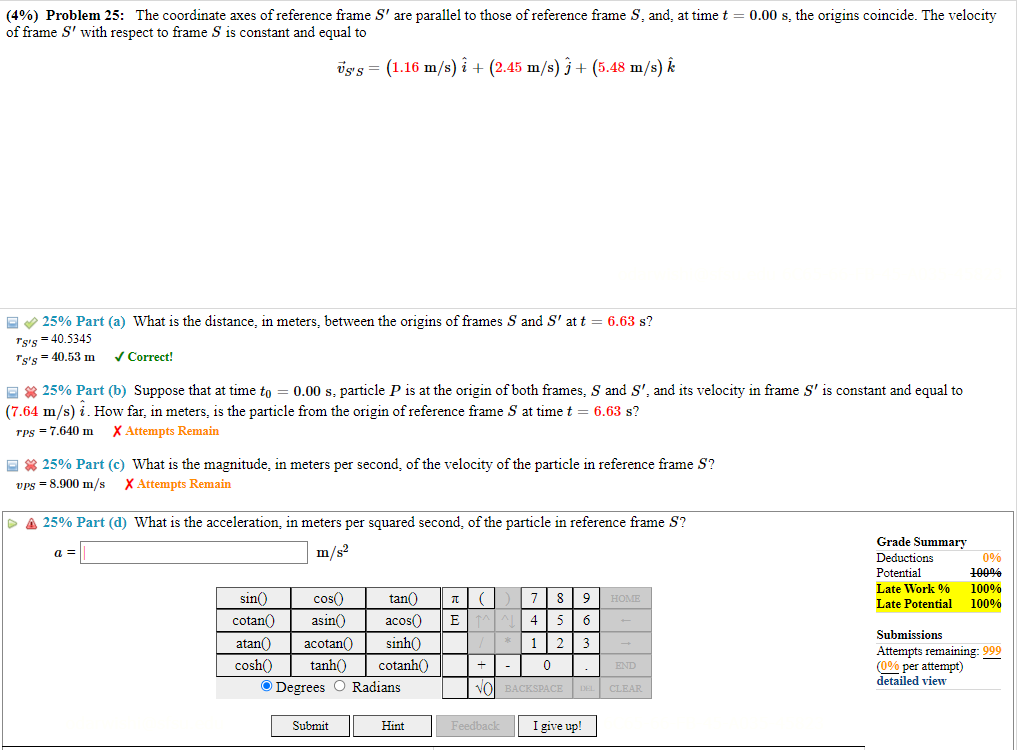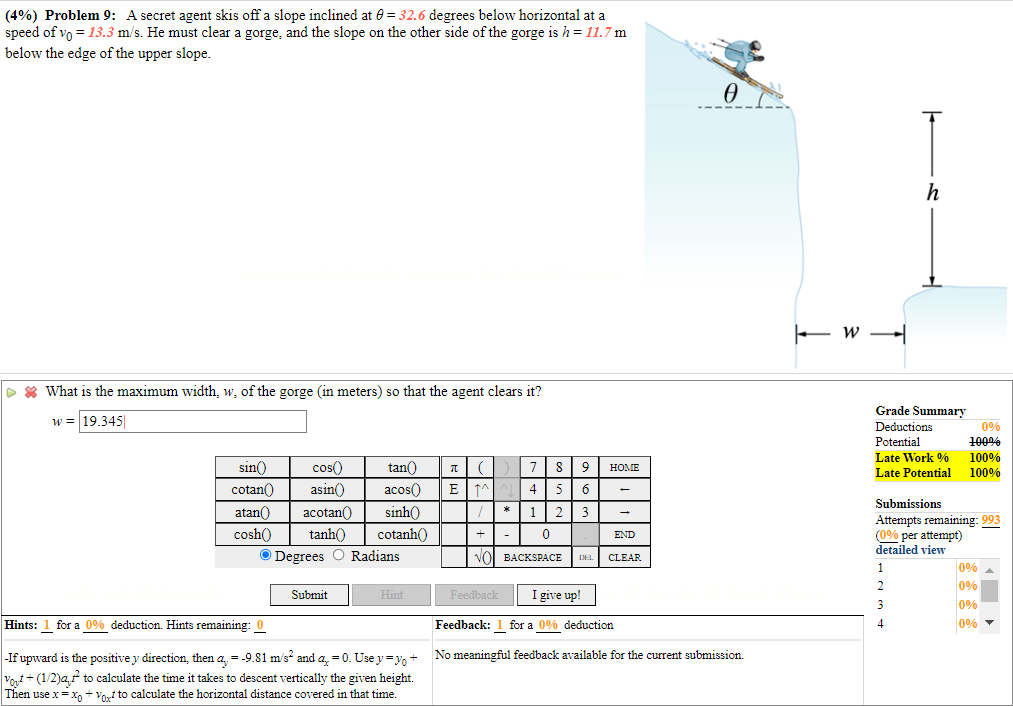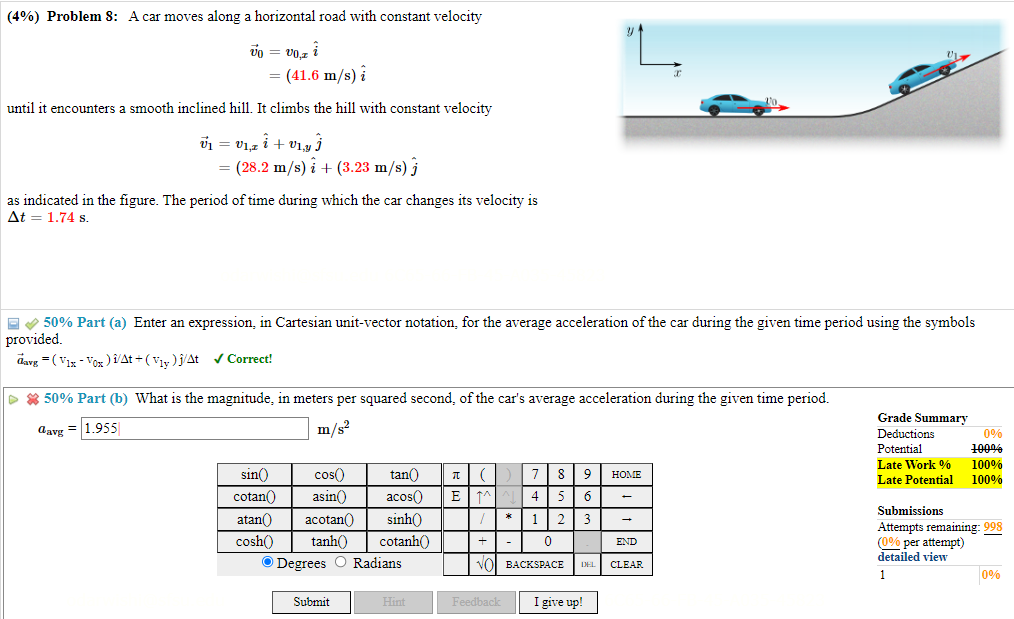Answered step by step
Verified Expert Solution
Question
1 Approved Answer
(4%) Problem 25: The coordinate axes of reference frame S' are parallel to those of reference frame S, and, at time t of frame



(4%) Problem 25: The coordinate axes of reference frame S' are parallel to those of reference frame S, and, at time t of frame S' with respect to frame S is constant and equal to = gs - (1.16 m/s) + (2.45 m/s) } + (5.48 m/s) k 25% Part (a) What is the distance, in meters, between the origins of frames S and S' at t = 6.63 s? Ts's 40.5345 = 0.00 s, the origins coincide. The velocity Ts's 40.53 m Correct! 25% Part (b) Suppose that at time to = 0.00 s, particle P is at the origin of both frames, S and S', and its velocity in frame S' is constant and equal to (7.64 m/s) i. How far, in meters, is the particle from the origin of reference frame S at time t = 6.63 s? rps = 7.640 m X Attempts Remain 25% Part (c) What is the magnitude, in meters per second, of the velocity of the particle in reference frame S? ups 8.900 m/s XAttempts Remain 25% Part (d) What is the acceleration, in meters per squared second, of the particle in reference frame S? a = m/s sin() cotan cos tan atan acotan cosh() tanh() Degrees Radians asin() acos sinh cotanh() (1) 7 8 9 EMN4 HOME 5 6 * 1 2 3 = - 0 END VO BACKSPACE DEL CLEAR Submit Hint Feedback I give up! Grade Summary Deductions 0% Potential Late Work % 100% 100% Late Potential 100% Submissions Attempts remaining: 999 (0% per attempt) detailed view (4%) Problem 9: A secret agent skis off a slope inclined at 0 = 32.6 degrees below horizontal at a speed of vo = 13.3 m/s. He must clear a gorge, and the slope on the other side of the gorge is h = 11.7 m below the edge of the upper slope. 0 w h What is the maximum width, w, of the gorge (in meters) so that the agent clears it? w=19.345| Grade Summary Deductions 0% Potential 100% Late Work % 100% sin() cotan cos( asin tan () 7 8 9 HOME Late Potential 100% acos EM4 5 6 - Submissions atan acotan sinh * 1 2 3 - cosh() tanh cotanh() = - 0 END Degrees Radians VO BACKSPACE DEL CLEAR Submit Hint Feedback I give up! Attempts remaining: 993 (0% per attempt) detailed view 1 0% 2 0% 3 0% 4 0% Hints: 1 for a 0% deduction. Hints remaining: 0 -If upward is the positive y direction, then a = -9.81 m/s and a = 0. Use y = y + You+(1/2)q to calculate the time it takes to descent vertically the given height. Then use xxoox to calculate the horizontal distance covered in that time. Feedback: 1 for a 0% deduction No meaningful feedback available for the current submission. (4%) Problem 8: A car moves along a horizontal road with constant velocity vo = vo,x i (41.6 m/s) = until it encounters a smooth inclined hill. It climbs the hill with constant velocity =(28.2 m/s) + (3.23 m/s) j as indicated in the figure. The period of time during which the car changes its velocity is At = 1.74 s. I 50% Part (a) Enter an expression, in Cartesian unit-vector notation, for the average acceleration of the car during the given time period using the symbols provided. davg =(Vix - Vox) i/At+(Vy) j/At Correct! 50% Part (b) What is the magnitude, in meters per squared second, of the car's average acceleration during the given time period. Gavg = 1.955 m/s Grade Summary Deductions 0% Potential 100% Late Work % 100% Late Potential 100% sin() cos tan () 78 9 HOME cotan asin() acos EMN4 5 - atan acotan sinh / * 1 2 3 cosh() tanh() Degrees Radians cotanh() = - END VO BACKSPACE DEL CLEAR 1 Submit Hint Feedback I give up! Submissions Attempts remaining: 998 (0% per attempt) detailed view 0%
Step by Step Solution
There are 3 Steps involved in it
Step: 1

Get Instant Access to Expert-Tailored Solutions
See step-by-step solutions with expert insights and AI powered tools for academic success
Step: 2

Step: 3

Ace Your Homework with AI
Get the answers you need in no time with our AI-driven, step-by-step assistance
Get Started


